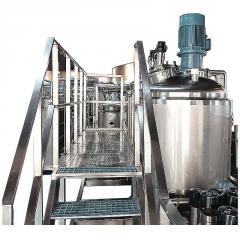
One stop solution for plant fermentation production line
——The complete path from 'a handful of grass in the field' to 'high-value shelf'
1、 Demand portrait
• Raw materials: Edible or medicinal plants of the same origin (tea, flowers, fruits, roots, seaweed, etc.)
• End products: plant enzyme solution, plant-based yogurt, plant fermented beverage, concentrated cream, functional powder/tablet
• Capacity: 500 L experimental line → 50 t/d commercial production line
Compliance: China SC, EU Novel Food, USDA Organic, ISO 22000, FSSC 22000
2、 Process Overview (Modular)
1. Pre processing → 2. Low temperature long-term fermentation (LTFS) → 3. Rapid aging → 4. Clarification/concentration → 5. Blending → 6. Aseptic filling → 7. CIP/SIP and data traceability
3、 The entire plant fermentation production line can be divided into 7 zones, each with key equipment and highlights:
1. Pre processing area
First, use a bubble cleaner to clean the raw materials, and then send them to an ozone sterilization tank, which can process 5 tons per hour with a sterilization rate of over 99%.
2. Crushing enzymatic hydrolysis zone
The high shear crusher breaks the plants into small pieces of ≤ 3 mm, and then vacuum degassing removes oxygen to prevent browning.
3. Ingredient area
The vacuum mixing tank is weighed according to the formula, with an error of no more than 0.2%. The inner liner is mirror polished and cleaned without residue.
4. Low temperature fermentation zone
Fermentation tanks with a capacity of 1000-20000 L can achieve precise temperature control of 5-30 ℃ ± 0.5 ℃, nitrogen protection, and anaerobic fermentation; Multiple tanks connected in series can be processed in 3-6 stages.
5. Clarify the concentration zone
First, remove large particles by centrifugation with a disc, then clarify with a 0.1 μ m ceramic membrane. Concentrate the liquid 2-6 times by RO or vacuum evaporation, and keep the temperature below 45 ℃.
6. Allocation and filling area
Online addition of spices and prebiotics in high shear emulsification tanks; The sterile cold filling machine injects the finished product into 125 mL-1 L PET bottles or Tetra Pak bricks, with residual oxygen<1%.
7. CIP/SIP area
Five level CIP cleaning+135 ℃ pure steam sterilization, fully computerized batch recording, one click traceability.
4、 Typical process route (taking "flower fruit enzyme solution" as an example)
1. Ingredients: Rose petals 10%, double petaled pomegranate 15%, oligofructose 5%, RO water 70%
Enzymatic hydrolysis: 45 ℃/1 h (pectinase+cellulase)
3 Vaccination: Compound lactobacillus (L. plantarum+L. casei) 0.05%
Phase 1: 20 ℃/30 days, pH reduced to 3.5
Stage 2: Add the second plant material (10% mulberries) and 5% second fermentation broth, and ferment for another 20 days
6 centrifugal clarification → RO concentration to 50 ° Brix → sterile cold filling → 12 months of room temperature shelving
5、 Digitization and Sustainability
MES+DCS: Batch recording, electronic signature, real-time presentation of OEE
• Energy recovery: Fermentation waste heat → Preheating bottle washing water, steam condensate → CIP reuse
• Packaging: 100% recyclable rPET bottles, biodegradable PLA cups
6、 Investment and return (50 t/d demonstration line)
Equipment investment: ≈ 18 million yuan (including public works)
• Construction period: 6-8 months
Annual output value: ≈ 120 million yuan (calculated based on terminal enzyme solution at 20 yuan/250 mL)
• Investment return period: 2.6 years (under full production)
7、 Conclusion
From "low-temperature long-term multiple fermentation" to "sterile cold filling", this plant fermentation production line solution can flexibly switch more than 20 high value-added products such as fruit and vegetable enzymes, plant-based yogurt, fermented beverages, functional concentrated pastes, etc. With modular design, digital control, and sustainable energy strategies, we provide customers with a one-stop, replicable, and scalable hardcore platform to quickly occupy the "plant fermentation+functional health" track.










